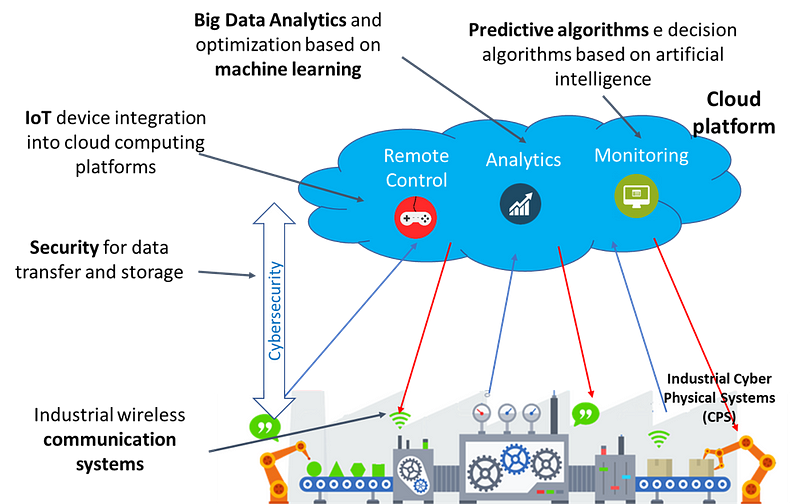As businesses increasingly adopt cloud computing, the complexity of managing these transformations grows. Organizations need precise tools and metrics to navigate this shift effectively. Without a clear framework, companies risk suboptimal performance and missed opportunities. This article explores the critical dashboards and metrics that can guide successful cloud transformations.
Market Analysis and Dynamics
The global cloud computing market is experiencing rapid growth, driven by the increasing adoption of cloud-based solutions across various industries. According to industry estimates, the global cloud computing market was valued at $677.95 billion in 2023 and is projected to grow to $2,432.87 billion by 2030, exhibiting a CAGR of 20.0% during the forecast period.
Cloud computing has become a fundamental technology that enables businesses to access scalable and cost-effective computing resources, storage, and software applications over the internet. The growing demand for cloud services is fueled by the rising need for digital transformation, the increasing adoption of emerging technologies like artificial intelligence (AI) and the Internet of Things (IoT), and the need for more agile and efficient IT infrastructure.
One of the key drivers propelling the cloud computing market is the expanding digital transformation initiatives across industries. As businesses strive to enhance their operational efficiency, improve customer experience, and stay competitive, they are increasingly turning to cloud-based solutions to streamline their IT infrastructure, enhance collaboration, and enable data-driven decision-making. The COVID-19 pandemic has further accelerated the adoption of cloud services as organizations rapidly shifted to remote work and online operations.
Furthermore, the integration of cloud computing with advanced technologies like big data, AI, and machine learning (ML) is further driving market growth. Organizations are leveraging cloud-based platforms to harness the power of these technologies for improved data analytics, predictive insights, and automation, leading to enhanced business outcomes. The increasing demand for scalable, secure, and cost-effective cloud solutions is expected to continue fueling the market’s expansion in the coming years.
Segmentation and Trends
The cloud computing market can be segmented based on various factors, including service type, deployment model, organization size, and industry vertical. These segments provide valuable insights into the different use cases and adoption patterns of cloud computing.
By service type, the market is divided into Software as a Service (SaaS), Platform as a Service (PaaS), and Infrastructure as a Service (IaaS). The SaaS segment currently dominates the market, owing to the growing demand for cloud-based business applications, productivity tools, and enterprise software. However, the IaaS segment is expected to witness the fastest growth during the forecast period, driven by the increasing adoption of cloud-based infrastructure solutions for data storage, computing, and networking.
In terms of deployment model, the market is classified into public cloud, private cloud, and hybrid cloud. The public cloud segment is projected to maintain its dominance, as it offers cost-effective, scalable, and easily accessible cloud services, particularly among small and medium-sized enterprises. The hybrid cloud segment, on the other hand, is expected to grow at a rapid pace, as it provides organizations with the flexibility to leverage the benefits of both public and private cloud environments.
The cloud computing market also caters to different organization sizes, ranging from large enterprises to small and medium-sized businesses (SMBs). While large enterprises have been early adopters of cloud solutions, the SMB segment is anticipated to witness significant growth in the coming years, as cloud-based services become more accessible and tailored to their specific needs.

Across industry verticals, the cloud computing market is segmented into BFSI, IT and telecommunications, government, healthcare, retail and consumer goods, manufacturing, and others. The IT and telecommunications sector currently holds the largest market share, driven by the industry’s high demand for cloud-based applications, data storage, and collaboration tools. The healthcare industry is also expected to witness rapid growth, as cloud computing enables the secure storage and sharing of patient data, supports telemedicine and remote patient monitoring, and helps streamline various healthcare operations.
Regional Dynamics and Outlook
Geographically, the cloud computing market is divided into five key regions: North America, Europe, Asia Pacific, Latin America, and the Middle East and Africa.
North America is expected to maintain its dominance in the global cloud computing market, driven by the presence of major cloud service providers, such as Amazon Web Services (AWS), Microsoft Azure, and Google Cloud, as well as the early adoption of cloud technologies by enterprises in the region. The United States and Canada are the leading contributors to the North American market, with a strong focus on digital transformation initiatives and the integration of cloud computing with emerging technologies.
The European cloud computing market is also poised for significant growth, as countries like the United Kingdom, Germany, France, and Italy increase their investments in cloud infrastructure and services. The growing emphasis on data sovereignty, compliance, and security regulations in the region is expected to drive the adoption of hybrid and private cloud solutions.
The Asia Pacific region is anticipated to experience the fastest growth during the forecast period, driven by the rapid digital transformation and increasing internet and mobile device penetration in countries like China, India, Japan, and the ASEAN nations. The growing demand for cloud-based services to support the region’s manufacturing, healthcare, and e-commerce sectors is expected to fuel the market’s expansion.
Meanwhile, the Latin American and Middle East and Africa regions are expected to witness steady growth in the cloud computing market, as countries in these regions work to improve their digital infrastructure and leverage cloud-based solutions to drive economic development and modernize their industries.
Competitive Landscape and Positioning
Cloud Service Providers
The global cloud computing market is characterized by the presence of several leading service providers, including Amazon Web Services (AWS), Microsoft Azure, Google Cloud, IBM, Oracle, and Alibaba Cloud, among others. These companies are continuously investing in research and development, product enhancements, and strategic partnerships to strengthen their market position and cater to the evolving needs of their customers.
Amazon Web Services (AWS) is the current market leader, offering a comprehensive suite of cloud-based services, including computing, storage, databases, analytics, and more. AWS has a strong global presence and a vast partner ecosystem, which has contributed to its dominant market share. Microsoft Azure, the cloud computing platform offered by Microsoft, is a close second, leveraging the company’s established enterprise customer base and its integration with Microsoft’s suite of productivity and business applications.
Google Cloud, the cloud computing division of Google, has also emerged as a major player in the market, offering innovative cloud-based solutions that leverage the company’s expertise in artificial intelligence, machine learning, and data analytics. Other prominent players, such as IBM, Oracle, and Alibaba Cloud, are also making significant investments to expand their cloud service offerings and capture a larger share of the growing market.
Cloud Transformation Consultancies
The competitive landscape is further enriched by the presence of numerous regional and specialized cloud transformation consultancies. These consultancies offer services ranging from cloud migration and implementation to optimization and managed services, helping organizations navigate the complexities of cloud adoption and maximize the benefits of their cloud investments.
Accenture, a leading global professional services firm, has built a strong practice in cloud transformation advisory and implementation. The company’s extensive industry expertise, global delivery capabilities, and partnerships with all major cloud providers position it as a trusted advisor for enterprises undergoing cloud transformations.
Deloitte, another prominent professional services firm, has also made significant investments in its cloud transformation consulting practice. The company’s deep understanding of industry-specific requirements, combined with its robust suite of cloud assessment, migration, and optimization services, has made it a preferred partner for many organizations.
TCS (Tata Consultancy Services), as one of the largest IT services providers globally, has built a strong cloud transformation and implementation practice. TCS leverages its extensive experience in large-scale IT transformations, combined with its partnerships with leading cloud providers, to help enterprises successfully navigate their cloud journeys.
As the cloud computing market continues to evolve, the competition among the leading players is expected to intensify, with a focus on technological innovation, industry-specific solutions, and strategic partnerships to differentiate their offerings and meet the diverse needs of customers across various sectors.
Optimizing Cloud Transformation Outcomes
As organizations continue to embrace the benefits of cloud computing, measuring the progress and impact of their cloud transformation initiatives has become increasingly critical. To drive successful outcomes, companies must track a comprehensive set of metrics and key performance indicators (KPIs) that provide a clear and holistic view of their cloud transformation journey.
The success of a cloud transformation initiative can be evaluated across eight critical dimensions:
1. Cloud Adoption: This dimension tracks the pace and extent of cloud adoption within the organization, including metrics like the percentage of workloads migrated to the cloud, the rate of cloud service adoption, and the number of cloud-native applications developed.
2. Cost Optimization: Monitoring cloud-related costs and identifying opportunities for optimization is essential. Relevant metrics include cloud spend as a percentage of total IT budget, cloud cost per user, and cost savings realized through cloud migration and optimization.
3. Operational Efficiency: Metrics in this dimension assess the impact of cloud transformation on operational efficiency, such as infrastructure utilization rates, incident response times, and the frequency of manual interventions required for cloud operations.
4. Scalability and Elasticity: Cloud-based infrastructure should provide the agility to scale resources up or down as needed. Metrics to track include the time required to provision new resources, the variability in resource utilization, and the ability to handle unexpected spikes in demand.
5. Security and Compliance: Ensuring the security of cloud-hosted data and applications, as well as compliance with relevant regulations, is a top priority. Relevant metrics include the number of security incidents, the percentage of cloud workloads with appropriate security controls, and the time required to detect and respond to security threats.
6. Business Value: This dimension focuses on the tangible business benefits of cloud transformation, such as increased revenue, improved customer experience, and enhanced employee productivity. Metrics may include sales pipeline growth, customer satisfaction scores, and employee efficiency indicators.
7. Innovation and Agility: Cloud adoption should enable organizations to be more innovative and agile in responding to market changes. Relevant metrics include the time-to-market for new products or services, the frequency of software releases, and the number of successful proofs of concept or pilots.
8. Organizational Transformation: Successful cloud transformation requires cultural and organizational changes. Metrics in this dimension may include employee adoption of cloud-based tools, the level of cross-functional collaboration, and the overall change in organizational mindset and capabilities.
Designing Effective Cloud Transformation Dashboards
To effectively track and manage cloud transformation initiatives, organizations should develop comprehensive dashboards that consolidate data from these eight critical dimensions. These dashboards should provide a high-level summary of the organization’s overall cloud transformation progress and business impact, detailed metrics and KPIs for each dimension, and visualization tools to make data easily interpretable. The dashboards should also have capabilities for data integration, aggregation, and real-time updates to ensure the information reflects the latest developments.
Implementing Robust Cloud Transformation Measurement
Establishing a robust cloud transformation measurement framework requires careful planning and execution. Organizations should clearly define their cloud transformation objectives, ensure the necessary data collection and reporting infrastructure is in place, and establish processes for regular data review and analysis. By empowering cross-functional teams to use the cloud transformation dashboards, organizations can gain valuable insights, make informed decisions, and optimize the outcomes of their cloud migration and transformation initiatives.
By implementing a comprehensive cloud transformation measurement framework, organizations can gain valuable insights, make informed decisions, and optimize the outcomes of their cloud migration and transformation initiatives.









